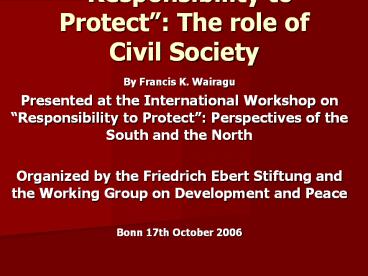- PowerPoint PPT Presentation
1 / 11
Title:
Description:
Responsibility to Protect : The role of Civil Society By Francis K. Wairagu Presented at the International Workshop on Responsibility to Protect ... – PowerPoint PPT presentation
Number of Views:16
Avg rating:3.0/5.0
Title:
1
Responsibility to Protect The role of Civil
Society
- By Francis K. Wairagu
- Presented at the International Workshop on
Responsibility to Protect Perspectives of the
South and the North - Organized by the Friedrich Ebert Stiftung and the
Working Group on Development and Peace - Bonn 17th October 2006
2
Introduction
- Responsibility to Protect rises out of the
failure by international community failure to
adequately respond to the 1990s crises. - It is a recasting of a new approach to such
crises - Attention is moved from the Right to intervene
to the Responsibility to Protect - The intention is bring about norms, or guiding
principles of behaviour for the international
community of states in seeking people welfare. - The justification for this conceptual shift rests
in the new focus on human rights and more
recently on the human security emphasis that
limits the sovereignty of states
3
The Guiding Tenets
- The responsibility to prevent to address both
the root causes and direct causes of internal
conflict and other man-made crises putting
populations at risk. - The responsibility to react to respond to
situations of compelling human need with
appropriate measures, which may include coercive
measures like sanctions and international
prosecution, and in extreme cases military
intervention. - The responsibility to build to provide,
particularly after a military intervention, full
assistance with recovery, reconstruction, and
reconciliation, addressing the causes of the harm
the intervention was designed to halt or avert.
4
Role of Civil Societya) To the General Concept
- Expounding on the concept or the principles eg
What does Responsibility and Protection mean? - Taking the debate out to the people
- Engaging governments to measure willingness and
any challenges - Suggesting ways and means of improving the
concept - Partner with governments and monitor
implementation - Hold governments accountable where action is
delayed or not taken at all. - Maintain their roles in the prevention and
protection.
5
b) Under Prevention
- Research and situational analysis
- Engaging state leaderships and seeking
international response to deserving cases - Peace building and conflict transformation
- Partner with governments but maintain
independence - Development for peace initiatives
- Participate in the processes of building good
governance - Encourage institutional transformation to
stabilize governance
6
c) Under the Responsibility to React
- It is the most challenging stage because there is
confrontation - Maintain the protection of civilians even in the
confrontation, humanitarian assistance - Monitor the interveners to ensure that they keep
to the rules of engagement. - Build capacity for local take over after the
intervention
7
d) Under the responsibility to build
- Lobbying governments for resources to rebuild
- Monitor exploitation of local resources by the
interveners - Encourage and build capacity for local
participation - Offering post-conflict therapy
- Encourage interveners to leave at appropriate
times - Further peace building and reintegration
- Re-construction of governance and appropriate
state institutions - etc
8
What opportunities does it provide
- It looks at the issues from the perspective of
those seeking or needing support, rather than
those who may be considering intervention. - It implies that the primary responsibility rests
with the state concerned, and that it is only if
the state is unable or unwilling to fulfil the
responsibility to protect, or is itself the
perpetrator, that it becomes the responsibility
of the international community to act in its
place. - To protect implies more than to intervene it
embraces not just a responsibility to react, but
to prevent and rebuild as well. - Above all, new language helps clarify and
redirect the policy debate the actors have to
change their lines, and think afresh about what
the real issues are.
9
How does it feed into other mechanism
- 1. In the case of Africa, there are clear roles
for AU to intervene in countries where there are
serious human rights abuse among others - 2. Both the AU and NEPAB have clear avenues for
civil society engagement and holding member
states accountable. - 3. There are already regional bodies ready to
intervene if one of their own is abusing human
rights, allows genocide like activities, ECOWAS,
IGAD, etc - 4. Civil society has been doing peace building
and most regions are currently busy revamping
regional Stand by Protection - 5. The Great Lakes UN conference is a good
example - 6. The Nairobi SALW Protocol is another example
10
How it is being used in my region
- It is rather new and un-understood
11
Challenges
- The current UN system especially the Security
Council and its process - The international relation theory of self
interests - Excuses not to and lack of capacity for response
by various states - Too late responses
- What happens to situations where there no
prospects for regaining what is spent on reaction - The question of enforcement to states or the UN o
take responsibility, deaths, funds, etc - Civil society is dependent on states for funding
and as such will somehow pursues certain
interests, lack of coordination etc































